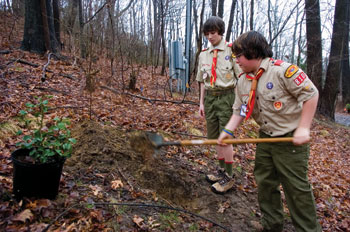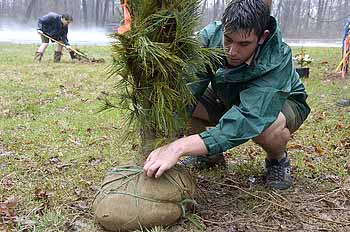Planting the Seeds for A Legacy of Service
By S. C. Torrington
Photographs By Walter Calahan
Scouts in a Maryland troop dedicate themselves to helping maintain one of the last remaining freshwater tidal marshes in the upper Chesapeake Bay.
 Corey Dregier digs out a hole while Jacob Olah waits to place a new plant in the opening. |
Otter Point Creek had turned the color of chocolate milk.
But three days of April showers hadn't muddied Boy Scout Troop 810's enthusiasm for their spring service project. The location was the Anita C. Leight Estuary Center (ACLEC) in Abingdon, Md., north of Baltimore.
A steady rain continued as two dozen Scouts, their leaders, and a few dedicated parents dug holes and plopped in native trees, including river birch, red twig dogwood, and American holly.
By the time those saplings grow enough to provide the intended sound barrier, these Scouts will be grown men. And that is exactly the legacy-of-service effect that Scoutmaster Mark Lynn had in mind four years ago when he suggested this ongoing service project to the Scouts and leaders.
Troop 810 'adopts' a park
"We wanted something the boys could really sink their teeth into," said Lynn, "and something that was environmental."
Almost from the moment Troop 810 was rechartered to St. Francis de Sales Catholic Church in February 2001, its leaders began considering a meaningful service project as part of their goal to help each Scout reach his fullest potential.
The leaders decided to focus their efforts on one "signature" service project combining a local community and conservation-based program.
They knew that, like most boys, the Scouts enjoyed the outdoors, especially when it presented the opportunity to get sloppy, dirty, and wet. They also realized that, to get the full value from the experience, the Scouts needed to tackle projects that didn't promise to always be 100 percent fun.
Less than a mile away from Troop 810's meeting place, waiting to be "adopted" as part of the Harford County Department of Parks and Recreation's (HCDPR) new Adopt-A-Park Program, was the estuary center, the visitor and education facility of the Chesapeake Bay National Estuarine Research Reserve—Maryland.
Starting small and growing
The Adopt-A-Park Program, a concept that is gaining popularity around the globe, was implemented in Harford County in 2002 as a way to involve citizens in the care and beautification of 66 county parks, open spaces, and facilities covering more than 3,300 acres.
"It's been a perfect fit," said former park manager Heather Helm.
Beginning in September 2002 as a basic twice-a-year cleanup project, the park quickly blossomed into a bimonthly commitment for bigger-and-better projects. The Scouts, with their youthful enthusiasm and muscle, jumped into laborious jobs, such as clearing out a backyard garden, mulching the trails, and building steps on a new wood trail.
Plenty of service hours and badges were accumulated, but most of the troop put in more time at the Leight Center than was required.
For example, Troop 810 directed traffic and offered assistance at ACLEC's Annual Wade-In water-quality awareness event, which drew hundreds of sneaker-wearing visitors who stepped into the estuary to measure quality the old-fashioned way, gauging it by how far they could wade until they could no longer see their shoes.
In October 2004, the troop took on the new responsibility to build, mount, maintain, and monitor barred owl nesting boxes.
 Adam Scowden carefully unties the root ball of a young pine tree. |
This project required a higher level of skill, finesse, and teamwork, and could have been accomplished by a few of ACLEC's adult volunteers. But because of their record of committed service to the center, the Scouts were assigned the project.
Troop 810's record of good works also landed them on the cover of HCDPR's 2004-2005 Guide to Leisure Programs and Facilities, distributed countywide.
Flattered by the cover picture, the troop was even more honored by park manager Helm's kind words inside the publication: "Leight Park's staff is very grateful to have such enthusiastic Scouts as Troop 810 adopt their park and look forward to many more productive days together."
Adding Eagle projects
By the end of 2004, several Life Scouts had consulted with ACLEC staff regarding the possibility of extensive environment-based Eagle Scout service projects, an offer that greatly pleased new park manager Shanna Schoen.
The center had long been in need of an updated field guide for the "Family Fun Packs" (filled with trail maps, activities for children, conservation tips, and a small trash bag) that visitors use to enhance their self-guided park tours. Scout Stephen Lynn recruited younger troop members to help research and photograph more than 80 local flora and fauna. Stephen helped organize various money-earning events to help publish the 65-page manual.
Many park visitors walk the trails but don't stop in to look at posted maps, program information, and updates. Walter Scowden III, son of new Scoutmaster Walt Scowden, proposed building a kiosk along the Discovery Trail. Add-ons may include stepping-stones, mulching, and benches.
Even Scouts planning their Eagle service projects elsewhere—an amphitheater, a bridge, or playground equipment at St. Francis de Sales; a courtyard for a local public school; a Civil War presentation—all utilize knowledge and skills acquired through their ACLEC service time.
A vision for the future
So it's not bragging, just fact, when Mark Lynn, who now serves as an assistant Scoutmaster, said that these rich, varied outcomes were all part of the troop leaders' original vision.
"Initially, the boys didn't see all the opportunities. They were just having fun," added Scoutmaster Scowden. "But now, over the years, they see the possibilities for Eagle Scout projects and beyond."
"The Scouts feel a sense of connection to the center," said park manager Schoen. "Not only is it a cool place to be a part of, but they know what they do here really matters. Our staff isn't just finding tasks to fill time; we count on the Scouts. We also try hard to give them hands-on and varied activities."
Life Scout Sean Glover expressed appreciation for the inspiration provided by troop leaders. "I'm motivated to participate because our leaders help every boy feel like he's an important part of the project," he said.
"Working at the estuary center isn't just a service project," First Class Scout Conor Perkins soon discovered. "You get to make long-lasting friends, because everybody here has the same attitudes about the importance of conservation."
Assistant Scoutmaster Lynn, who still heads the troop's Adopt-A-Park project, envisions expanding the partnership to include involvement with the center's popular summer camps and long-term environmental research. He's confident that each Scout will find some aspect of his relationship with the ACLEC to fit his interests, needs, and strengths.
"The tenacity to commit to one major service project has definitely been worthwhile," said Lynn. "Focus brings rewards."
Freelance writer S. C. Torrington lives in Joppa, Md.
If You Want to Adopt-A-ParkAn Adopt-A-Park or similar environmental service project is a partnership established to fill the needs of both the park and the Scouts providing service. Here are some tips for developing such an arrangement.
Know your Scouts.
Think locally.
Listen to park personnel.
Keep it interesting.
Encourage Eagle service projects.
Be trailblazers. —S.C.T. |
Where to Find OpportunitiesIn most cities there's some type of community "adoption" program—from airports to zoos. For troops in search of an environmental-based service project, options include Adopt-A-Beach, Desert, Forest, Mountain, Pond, Stream, Trail, Wash or Watershed. Nationwide, however, the Adopt-A-Park program seems to offer the most diverse selection. The needs, requirements, and limitations of each park will vary. Your city or county department of parks and recreation can provide information about existing programs and its policies. Discuss the park's expectations with its manager or horticulturist. Review the contract agreement with your troop before making any commitment. Parks devoted to sporting events, where the grounds are primarily mowed grass, may want just occasional cleanups with simple planting around signage. But management may be open to small birdhouses, a butterfly garden, or other wildlife buffers, good projects for younger Scouts. On the other hand, some parks are vast acres of land. These areas may offer varied opportunities for plantings, construction, and flora or fauna research more appropriate for older Scouts. Consider a local park that your troop already uses and enjoys. Talk about ways they'd like to improve the area. Then offer to "adopt" it. —S.C.T. |
November - December 2005 Table of Contents
Copyright © 2005 by the Boy Scouts of America. All rights thereunder reserved; anything appearing in Scouting magazine or on its Web site may not be reprinted either wholly or in part without written permission. Because of freedom given authors, opinions may not reflect official concurrence.